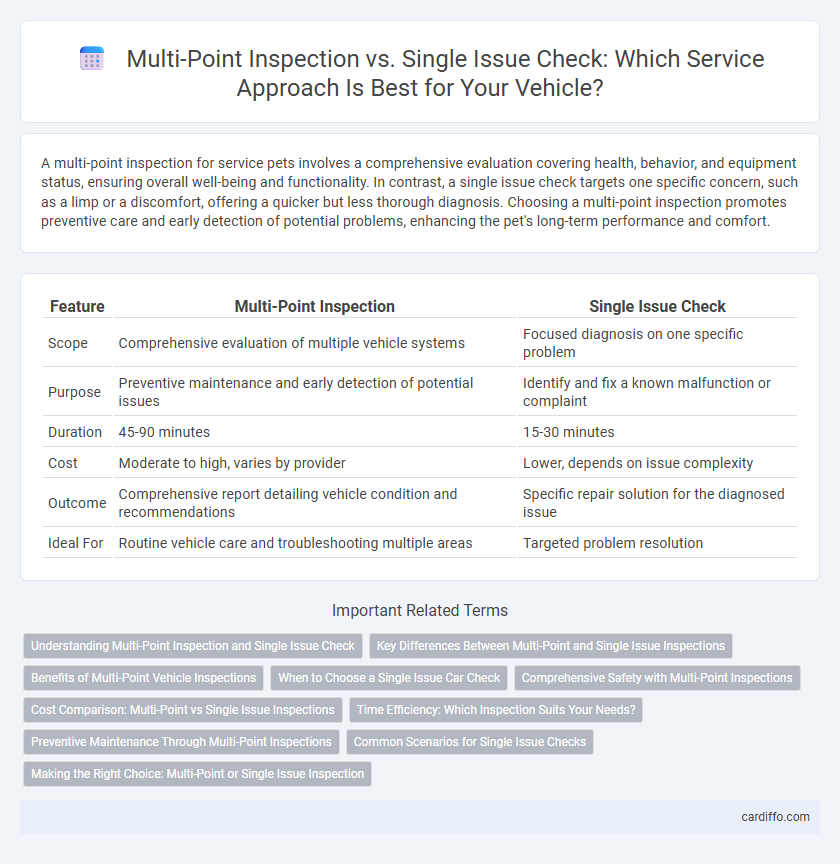A multi-point inspection for service pets involves a comprehensive evaluation covering health, behavior, and equipment status, ensuring overall well-being and functionality. In contrast, a single issue check targets one specific concern, such as a limp or a discomfort, offering a quicker but less thorough diagnosis. Choosing a multi-point inspection promotes preventive care and early detection of potential problems, enhancing the pet's long-term performance and comfort.
Table of Comparison
| Feature | Multi-Point Inspection | Single Issue Check |
|---|---|---|
| Scope | Comprehensive evaluation of multiple vehicle systems | Focused diagnosis on one specific problem |
| Purpose | Preventive maintenance and early detection of potential issues | Identify and fix a known malfunction or complaint |
| Duration | 45-90 minutes | 15-30 minutes |
| Cost | Moderate to high, varies by provider | Lower, depends on issue complexity |
| Outcome | Comprehensive report detailing vehicle condition and recommendations | Specific repair solution for the diagnosed issue |
| Ideal For | Routine vehicle care and troubleshooting multiple areas | Targeted problem resolution |
Understanding Multi-Point Inspection and Single Issue Check
A Multi-Point Inspection evaluates multiple vehicle systems and components, providing a comprehensive assessment of overall condition and potential maintenance needs. In contrast, a Single Issue Check focuses on diagnosing and addressing one specific problem or symptom reported by the vehicle owner. Understanding the scope and purpose of each service helps in choosing the appropriate inspection based on vehicle condition and repair goals.
Key Differences Between Multi-Point and Single Issue Inspections
A Multi-Point Inspection involves a comprehensive evaluation of multiple vehicle systems, including brakes, tires, fluids, and engine components, to identify potential issues beyond the initially reported problem. In contrast, a Single Issue Check targets one specific problem or symptom, focusing diagnostic efforts solely on that area. The multi-point approach helps prevent future breakdowns by addressing hidden concerns, while the single issue check enables quicker resolution of isolated faults.
Benefits of Multi-Point Vehicle Inspections
Multi-point vehicle inspections provide a comprehensive assessment by examining critical systems such as brakes, tires, fluids, and engine components, ensuring early detection of potential problems. This thorough approach enhances vehicle safety, prevents costly repairs, and extends the lifespan of the vehicle compared to single issue checks that address only one specific concern. Regular multi-point inspections contribute to improved fuel efficiency and overall vehicle reliability, offering superior value to routine maintenance.
When to Choose a Single Issue Car Check
A Single Issue Car Check is ideal when a specific problem arises, such as unusual engine noise or a brake warning light, allowing for a targeted diagnosis and repair. This focused approach saves time and cost by addressing the exact concern without a comprehensive vehicle review. Opting for a single issue inspection is practical for drivers needing quick fixes or when scheduling constraints prevent a full multi-point service.
Comprehensive Safety with Multi-Point Inspections
Multi-point inspections provide a comprehensive safety assessment by thoroughly examining crucial vehicle systems such as brakes, tires, engine, and suspension, identifying potential issues before they escalate. In contrast, single issue checks target one specific problem, often missing underlying or related concerns that could compromise overall safety. Regular multi-point inspections enhance reliability and prevent unexpected breakdowns, ensuring safer driving conditions and longer vehicle lifespan.
Cost Comparison: Multi-Point vs Single Issue Inspections
Multi-point inspections typically cost more upfront than single issue checks due to their comprehensive nature, covering numerous vehicle systems and components. Single issue inspections target specific problems, resulting in lower immediate expenses but potentially higher long-term costs if other issues go undetected. Investing in multi-point inspections can save money by preventing costly repairs through early detection and maintenance.
Time Efficiency: Which Inspection Suits Your Needs?
Multi-point inspections provide a comprehensive assessment by evaluating various vehicle systems in one session, making them more time-efficient for routine maintenance and preventing future issues. Single issue checks target specific problems, ideal for addressing immediate concerns but requiring additional visits if other issues arise. Choosing between them depends on whether you seek a thorough evaluation or a quick fix, balancing time and service depth for optimal vehicle care.
Preventive Maintenance Through Multi-Point Inspections
Multi-point inspections offer comprehensive preventive maintenance by evaluating critical vehicle systems such as brakes, tires, fluids, and engine components, reducing the risk of unexpected breakdowns. Unlike single issue checks that address isolated problems, multi-point inspections detect potential issues early, saving time and costly repairs. This proactive approach extends vehicle lifespan, enhances safety, and improves overall performance.
Common Scenarios for Single Issue Checks
Single Issue Checks are ideal for resolving specific problems such as engine misfires, brake pad wear, or overheating, allowing technicians to focus precisely on the malfunctioning component. This targeted approach reduces diagnostic time and minimizes costs when a clear symptom or warning light indicates a particular issue. In contrast to Multi-Point Inspections, which cover comprehensive systems, Single Issue Checks address isolated faults commonly reported by vehicle sensors or driver observations.
Making the Right Choice: Multi-Point or Single Issue Inspection
Choosing between a multi-point inspection and a single issue check depends on the vehicle's condition and owner's priorities. Multi-point inspections thoroughly assess critical systems like brakes, engine, and suspension, identifying potential problems before they escalate. Single issue checks focus on specific concerns, offering a faster, more cost-effective solution for isolated problems without addressing broader vehicle health.
Multi-Point Inspection vs Single Issue Check Infographic

 cardiffo.com
cardiffo.com